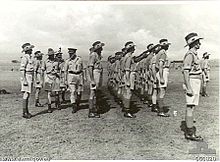History
The 2/12th was founded at Sydney Showground on 22 November 1940. Consisting of a headquarters company and two deployable companies, the unit consisted of 12 officers and 250 soldiers and had the capacity to provide medical support at brigade-level including battlefield casualty collection and initial wound treatment. Under the command of Lieutenant Colonel Nathaniel Barton, who had previously served as commanding officer of the 6th Light Horse Regiment, the unit was attached to the 23rd Infantry Brigade, 8th Division. Most of the recruits were from rural New South Wales. During their training in the Northern Territory, the members of the 2/12th provided medical support for the 23rd Brigade, participated in the construction of five small medical hospitals, and assisted sappers and pioneer assault units, earning the unit the nickname "2/12th Pioneers".
Following the beginning of the Pacific War, 50 members of the 2/12th were each attached to Gull Force and Sparrow Force, and sent to defend the islands of Ambon and Timor respectively. All of the members of the 2/12th serving with Gull Force were captured or killed by the Japanese on 1 February 1942, with many dying as prisoners of war on Ambon or Hainan. Many of those serving with Sparrow Force were also captured.
After this, the half-strength unit was reinforced and rebuilt in Darwin, where the unit remained until January 1943, continuing to support the 23rd Brigade. After being relieved by the 2/13th Field Ambulance, the 2/12th moved to the Wollongong–Illawarra area, to support the 9th Brigade while more personnel were posted into the unit from the 1st Division's medical units to bring it up to full strength. Finally, the unit was ready to deploy overseas and on 10 May 1943, the 195 members of the 2/12th boarded hospital ship Centaur to be transported to New Guinea, where they were scheduled to relieve the 3rd Field Ambulance in Port Moresby. On 14 May 1943, at 4:00 a.m., Centaur was torpedoed by Japanese submarine I-177, and sank in less than three minutes. Of the 332 aboard, there were only 64 survivors, including 15 members of the 2/12th. It was 13 hours before they were rescued by USS Mugford.
The survivors were reinforced by men from the 4th Light Field Ambulance, and was the 2/12th briefly attached to the 1st Division around Belgownie before being attached at corps-level to I Corps on the Atherton Tablelands in Queensland, arriving there in November 1943. In early 1944, the unit re-established itself at Wongabel in preparation for deployment to New Guinea where Australian forces were fighting around the Huon Peninsula. In the end, the unit was not deployed there and had to wait until 1945 before it would be sent overseas again, when it was committed to the Borneo campaign. In February, the unit was despatched to Morotai from where it would eventually detach elements to Tarakan, Lutong, and Kuching to support the 26th and 20th Brigades, both part of the 9th Division. The unit was disbanded in 1946, having served past the war's end, working with the retrieval and care of Allied prisoners of war. During the war, according to author Graham McKenzie-Smith, the unit had the "highest casualty rate of a non-combatant unit in the Australian Army".
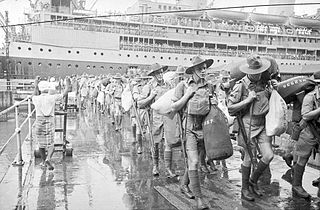
The 8th Division was an infantry division of the Australian Army, formed during World War II as part of the all-volunteer Second Australian Imperial Force. The 8th Division was raised from volunteers for overseas service from July 1940 onwards. Consisting of three infantry brigades, the intention had been to deploy the division to the Middle East to join the other Australian divisions, but as war with Japan loomed in 1941, the division was divided into four separate forces, which were deployed in different parts of the Asia-Pacific region. All of these formations were destroyed as fighting forces by the end of February 1942 during the fighting for Singapore, and in Rabaul, Ambon, and Timor. Most members of the division became prisoners of war, waiting until the war ended in late 1945 to be liberated. One in three died in captivity.

The 3rd Brigade is a combined arms brigade of the Australian Army, principally made up of the 1st and 3rd Battalions of the Royal Australian Regiment. Initially raised in 1903 as part of the post-Federation Australian Army, it was removed from the order of battle in 1906 following the restructure of the field force. It was re-formed in 1914 for service during World War I, taking part in the fighting at Gallipoli and on the Western Front in Europe. During World War II the brigade was used in a defensive role before it was disbanded in 1944. It was re-raised in 1967 for service during the Vietnam War and later went on to provide the nucleus of the deployment to East Timor during the Australian-led intervention in 1999. The brigade is currently based at Lavarack Barracks in Townsville, Queensland.

I Corps was an Australian Army corps, one of three that were raised by the Army during World War II. It was the main Australian operational corps for much of the war. Various Australian and other Allied divisions came under its control at different times. In 1940–1942, the corps was based in the Mediterranean and Middle Eastern theatres, and controlled forces in action against the Germans, Italians and later the Vichy French in North Africa, Greece and Syria–Lebanon.

Northern Territory Force was an Australian Army force responsible for protecting the Northern Territory during World War II. Most units assigned to the Northern Territory Force were based near Darwin and were responsible for defending the important naval and air bases in and around the town against a feared Japanese invasion. Northern Territory Force was renamed the 12th Division in late 1942 but this was short-lived. Australian Army units were rotated through northern Australia during the war and six infantry brigades served as part of Northern Territory Force between 1942 and 1945. The formation was reduced over the course of the war as the strategic situation in the Pacific turned in the Allies' favour, although remnants remained until the end of the war. In early 1946, it was converted back to the 7th Military District.
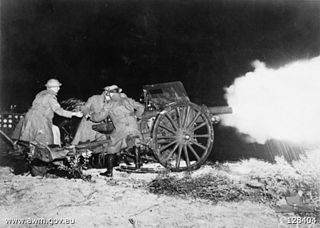
The 1st Regiment, Royal Australian Artillery is a close support regiment attached to the 7th Brigade at Enoggera Barracks in Queensland. The unit was formed in 1914 under the name 1st Australian Field Artillery Brigade, part of 1st Division Artillery during World War I and later served in World War II and the Vietnam War. It is currently re-equipping with M777A2 lightweight towed howitzers.

The 1st Health Battalion is a unit of the 2nd Health Brigade. It is headquartered at the Robertson Army Barracks in Darwin. Formally having sub-units located in Darwin, Townsville and Brisbane, the then 1st Close Health Battalion (1CHB) was raised as 1 HB and fell under the command of the reestablished 2nd Health Brigade in 2022; with the existing Sub-Units being absorbed into 4th Health Battalion (Australia), and 2nd Health Battalion (Australia), respectfully. Additionally, a Close Health Unit was founded under the command of the 3rd Health Battalion (Australia), cementing the new capabilities of Joint Health.

The 11th Brigade is an Australian Army brigade which currently comprises most Australian Army Reserve units located in Queensland. The brigade was first formed in early 1912 following the introduction of the compulsory training scheme. Later, as part of the 3rd Division and saw action during World War I on the Western Front as part of the First Australian Imperial Force. In the interwar years, the brigade was re-raised with its headquarters in Brisbane.

8th Brigade is an Australian Army Reserve training formation. It is headquartered in Sydney, and has subordinate units in various locations around New South Wales and the rest of Australia. These units are tasked with delivering basic and initial employment training to Reserve soldiers.

The Royal Australian Army Dental Corps (RAADC) is a corps within the Australian Army. It was formed on 23 April 1943 during World War II as the Australian Army Dental Corps, before being granted the 'Royal' prefix in 1948. Prior to its formation dentists were part of the Australian Army Medical Corps. The role of the RAADC is to provide dental care to army personnel in order to minimise the requirement for the evacuation of dental casualties, to conserve manpower and to reduce the burden of casualty evacuation. In the post-war years, the corps has provided personnel to deployments in Japan, Korea and Vietnam. It has also contributed to peace-keeping operations in Somalia, Rwanda, Bougainville and East Timor.

The 6th Cavalry Brigade was a militia or Citizens Military Force (CMF) formation of the Australian Army based in South Australia. It originated from the 6th Light Horse Brigade and was later converted to the 6th Motor Brigade and eventually to the 6th Armoured Brigade. During World War II, the brigade undertook defensive garrison duties until its conversion to the armoured role in 1942. It did not see combat.

The 15th Brigade was an infantry brigade of the Australian Army. Originally raised in 1912 as a Militia formation, the brigade was later re-raised in 1916 as part of the First Australian Imperial Force during World War I. The brigade took part in the fighting on the Western Front in France and Belgium during 1916–1918 before being disbanded in 1919. After this it was re-raised as a part-time unit of the Citizens Force in 1921 in Victoria. During World War II the brigade undertook defensive duties and training in Victoria and Queensland, before being deployed to New Guinea in 1943. Over the course of 1943 and 1944, it took part in the Salamaua–Lae, Markham–Ramu campaigns before returning to Australia in late 1944. In mid-1945, the brigade was committed to the Bougainville campaign, before being disbanded following the end of hostilities.
The 3rd Motor Brigade was a formation of the Australian Army during the interwar years and early part of World War II. Initially raised in 1921 as the 3rd Cavalry Brigade in Victoria, it was a formation of the part-time Militia. It consisted of three light horse regiments, which were spread across several depots in regional Victoria. During World War II, the brigade was mobilised for defensive duties in December 1941 to defend against a possible invasion. In early 1942, it was converted into a motorised formation and was redesignated as the 3rd Motor Brigade. The brigade moved to Western Australia in late 1942 and remained there until August 1944 when it was disbanded without having seen combat.
The 33rd Brigade was a formation of the Australian Army established at the end of World War II. Formed in August 1945 at Morotai Island, it consisted of three Australian Imperial Force infantry battalions that were raised for occupation duties in the Dutch East Indies following Japan's surrender. After deployment to Timor and Ambon, it returned to Morotai when Dutch colonial rule was re-established. It was disbanded in early 1946 and its personnel demobilised.
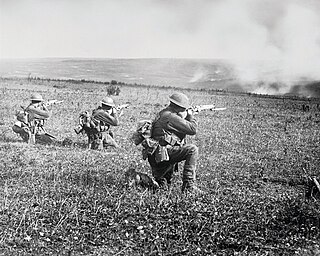
The 12th Brigade was an infantry brigade of the Australian Army. Formed in 1912 as a Militia formation, it was later re-raised in 1916 as part of the all volunteer First Australian Imperial Force that was raised for overseas service during the First World War. The brigade was part of the 4th Division and fought on the Western Front until the end of the war in November 1918. During the inter-war years, the brigade was re-formed in Australia as a part-time unit; during the Second World War, it was mobilised for full-time service, but did not serve overseas, undertaking garrison duties in Australia until 1945 when it was used to raise Timor Force.
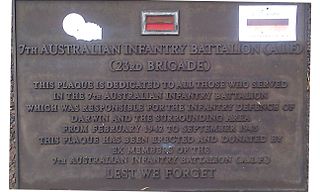
The 23rd Brigade was a brigade of the Australian Army. It was briefly raised in 1912 as a Militia formation providing training as part of the compulsory training scheme. Later, it was re-formed in July 1940 for service during the Second World War, the brigade was initially a formation of the Second Australian Imperial Force assigned to the 8th Division; however, after its sub units were captured by the Japanese in 1942 it was reformed with Militia battalions and was mainly used in a garrison role around Darwin, in the Northern Territory, until late in the war when it was committed to the fighting against the Japanese on Bougainville. It was disbanded in 1946.

The 2/5th Field Regiment was an Australian Army artillery regiment formed in May 1940 as part of the Second Australian Imperial Force for service during World War II. Assigned to the 7th Division, the regiment undertook defensive duties in Egypt during the North African campaign in early 1941, before taking part in the Syria–Lebanon campaign. Occupation duties followed before the regiment was brought back to Australia in early 1942, in response to Japan's entry into the war. The regiment subsequently fought two significant battles in New Guinea in 1942–1943 at Milne Bay and Buna before undertaking garrison duties around Port Moresby until early 1944. Withdrawn to Australia, the regiment's final campaign came late in the war when it was committed to the Borneo campaign, taking part landing at Balikpapan. The regiment was disbanded in early 1946.
The 2/21st Battalion was an infantry battalion of the Australian Army. Raised for service during Second World War as part of the Second Australian Imperial Force, it was formed on 11 July 1940 at Trawool in central Victoria as part of the 23rd Brigade of the 8th Division. It was subsequently deployed to Ambon as part of Gull Force in December 1941 following the Japanese invasion of Malaya; however, with the defence of the island considered untenable due to the limited military resources available and overwhelming Japanese strength it was subsequently captured despite determined resistance, surrendering on 3 February 1942. Most members of the battalion became prisoners of war, and a large number died in captivity.

The 8th Field Ambulance was a medical unit of the Australian Army. It was originally formed for service during World War I as part of the Australian Imperial Force, and served mainly on the Western Front between 1916 and 1918, before disbanding in early 1919. During World War II, the unit was re-raised as a Militia unit and served in Western Australia, New Guinea and Bougainville. During the Vietnam War, the unit served in Vung Tau in support of the 1st Australian Task Force between 1967 and 1968, before being disbanded in 1972. The unit's designation is now perpetuated by one for the 1st Close Health Battalion's close health companies.

Alexander Hammett Marks, was an Australian physician and military officer. Serving during the First World War, Marks was mentioned twice in despatches, and awarded the Distinguished Service Order, the Croix de Guerre, and made a Commander of the Order of the British Empire for his service.

The 2/3rd Anti-Tank Regiment was an Australian Army anti-tank artillery regiment that was raised for service during the Second World War as part of the all volunteer Second Australian Imperial Force. It was formed in July 1940, and was assigned to the 8th Division, but was later reassigned to the 9th Division. With this formation, the regiment took part in the Siege of Tobruk in 1941 and then the First and Second Battles of El Alamein in 1942. After returning to Australia in early 1943, the regiment became a corps-assigned unit, and its individual batteries served in New Guinea in 1943–1944, and then Borneo against the Japanese in 1945.
